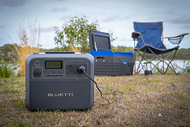What are Portable Power Stations.?
31st May 2024
In an increasingly mobile world, the need for portable and reliable power sources has never been greater. Portable power stations have emerged as a versatile solution for outdoor enthusiasts, campers, emergency preparedness, and even everyday use.
Portable power stations, also known as portable solar generators or power banks, are compact and lightweight devices designed to store electrical energy and provide power when you’re off the grid or during power outages. They typically consist of a battery, an inverter, various output ports (AC, DC, USB), and a way to recharge, often through solar panels, wall outlets, or car chargers.
Applications and Use Cases
Portable power stations have a wide range of applications, making them indispensable in various scenarios:
- Camping and Outdoor Adventures: Power your camping trips, charge devices, run lights, or even power small appliances.
- Emergency Backup: Keep essential devices running during power outages, ensuring communication and safety.
- Events: Run electronics, small appliances, or power outdoor entertainment setups.
- Caravan, RV and Van Life: Provide electricity in your mobile home or van without relying on a traditional generator.
- Remote Work: Stay connected and productive by powering your devices and internet equipment in remote locations.
Types of Portable Power Stations
Portable power stations come in several types, each catering to different needs:
- Battery Capacity: Varying from small, pocket-sized units to larger, high-capacity stations.
- Solar-Powered: Equipped with built-in solar panels or compatible for solar panel integration for eco-friendly recharging.
- Portable Power Banks: Smaller and highly portable units for charging small devices like smartphones and tablets.
Factors to Consider When Choosing a Portable Power Station
Selecting the right portable power station requires careful consideration of several factors:
- Capacity: Determine how much power you need based on the devices you plan to run and for how long.
- Battery Type: Lithium-ion batteries are common for their high energy density and longer life.
- Input and Output Ports: Ensure the station has the necessary ports for your devices, including AC outlets, USB ports, and DC outlets.
- Weight and Portability: Consider how often you’ll need to transport the unit and choose a weight that suits your needs.
- Recharge Options: Evaluate the available charging methods, such as solar, wall outlets, car chargers, or even hand-cranked options for emergencies.
- Inverter Quality: A high-quality inverter ensures stable and clean 240V power output.
- Durability and Build: Look for rugged and weather-resistant designs for outdoor use.
- Brand Reputation: Research the manufacturer’s reputation, customer reviews, and warranty options.
Maintenance and Care
While portable power stations are relatively low-maintenance, here are some tips to ensure their longevity:
- Regular Charging: Keep the unit charged if not in use to prevent the battery from draining completely.
- Cleanliness: Keep the ports and vents clean to prevent dust and debris from affecting performance.
- Storage: Store the power station in a cool, dry place away from extreme temperatures.
- Battery Health: If the unit uses lithium-ion batteries, avoid overcharging or deep discharging, as it can reduce battery life.
Portable power stations are versatile and indispensable devices that provide a reliable power source in various situations, from outdoor adventures to emergency backup. When considering options, consider factors like capacity, battery type, and recharge options to meet your specific needs.





